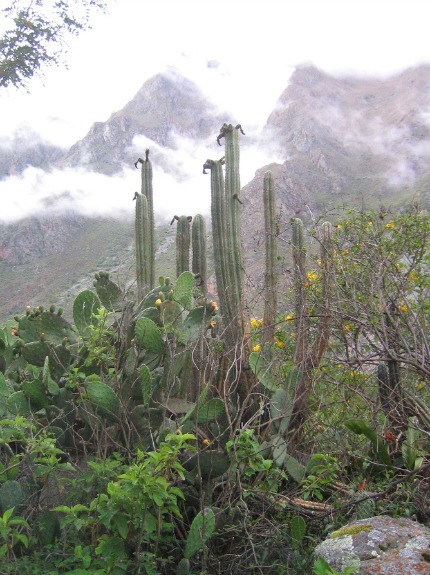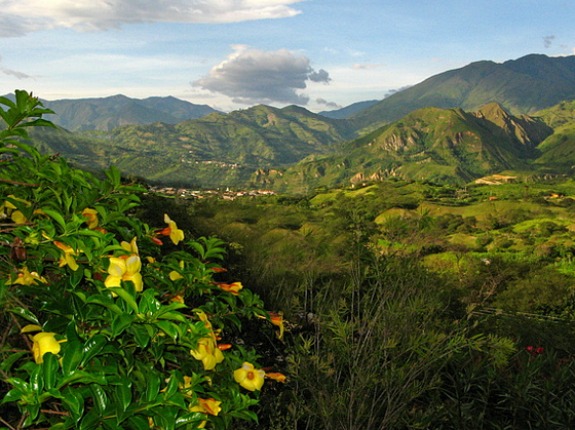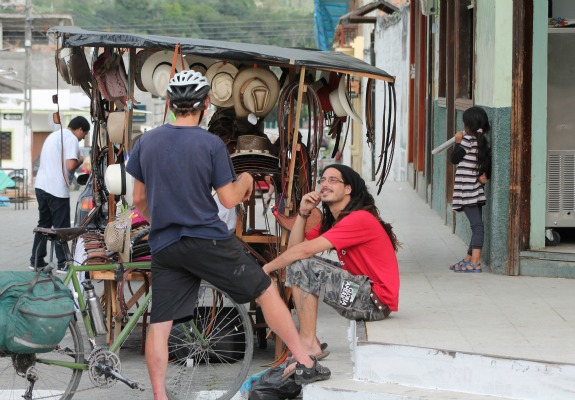Vilcabamba: Paradise Going Bad?
Life in this legendary town in Ecuador’s Valley of Longevity may be too good—and too long—to be true
The beauty of Vilcabamba and the Valley of Longevity has entranced many, inspired legends and attracted eccentrics, but the town may not quite live up to the lore. Photo courtesy of Flickr user johnrodgers.
In the Valley of Longevity, in southern Ecuador, visitors find the quiet and legendary town that has inspired travelers for decades—Vilcabamba. Once just another of a thousand beautiful Andean villages, this community of about 4,000 people is today one of the hottest destinations for outsiders seeking their own little piece of Shangri-La. The town, of affordable goods and productive soils, promises new life—not to mention long life—for both vacationers and expats, and in the past two decades Vilcabamba has become an uncanny magnet and New Age watering hole for soul-searchers dabbling in everything from agriculture to shamanism to hallucinogens.
But as one nears the village center along a cobblestone road that diverges from the highway, the legendary Vilcabamba seems too quiet for its reputation. Dozens of people sit idly in the square—well-to-do tourists, hippies with dreadlocks and bead necklaces, a few locals, men with week-old scruff and worn sandals—all of them waiting, it seems, for things to happen. As I cycled into the plaza, a friend of mine from Cuenca, Mick Hennessey, from Utah, was seated on a plaza bench, alertly watching the slow activity. He saw me and waved. “There’s nothing much going on here,” he said, seemingly reluctant to make such a decree so early. He had arrived only three hours before me by bus. “Sure is pretty up there, though,” I said, pointing at the mountain ridges surrounding this Valley of Longevity, so named for its supposedly high concentration of centenarians.
Another tourist, Nathan Resnick—an American currently living in Cuenca—spent several days in Cuenca hiking in the hills between nights at the Rendezvous guesthouse. He was glad with what he found.
“I was expecting a lot more and was pleasantly surprised that it didn’t exist,” Resnick said.
The town is surrounded by fantastic green ridges on the skyline and lush woods that make a paradise for backpackers, botanists and bird watchers. It is also the last chance for food and gear before entering Podocarpus National Park just to the east—home to bears and wild cats and countless bird species.
But according to some locals, Vilcabamba is unable to meet the needs or hopes of many who visit each year.
“People come here to solve their problems, but they never actually leave anything behind and so they bring all their baggage with them,” one man—a Canadian who has lived in Vilcabamba part time for a decade—told me about a block from the plaza, after we met and shook hands in the empty street. And so, he went on, health problems and mental maladies accumulate here with the immigrants. In particular, he said, conspiracy theories and UFO reports saturate local gossip. This interview by Uncornered Market of a resident Vilcabamban reads almost like a transcript of our conversation.
I quickly detected a very dark shadow hanging over the town. Only three days earlier, a woman had been raped on a trail in the woods just northeast of the town—the third such incident in just weeks. The alleged assailant was reportedly still at large. This January 25 blog post on Passionfruitcowgirl describes a dramatic attempted rape in what the author calls “Evilcabamba.” Another blog, Patryantravels, published a post last August titled “Paradise Lost,” which dwells on the steady rising tide of crime, both petty theft and physical assaults, that have damaged the pretty face of Vilcabamba. Among these recent events is the dramatic kidnapping for ransom that occurred in September on a nearby mountain trail, where a honeymooning couple was assaulted by three armed men wearing masks. The man was ordered to return to the town, retrieve several thousand dollars and deliver it back to the bandits, who said they would otherwise kill his wife. The couple survived the encounter—though the town’s reputation has taken a blow, and attentive eavesdroppers here can pick up on conversations in every direction about robbery, rape and the absence of the police.
Even as long ago as the 1970s, things seemed too good to be true in Vilcabamba. National Geographic, among other publications, had reported an unusually high number of centenarians in the village, but Dr. Alexander Leaf, of Harvard Medical School, was growing skeptical of villagers’ claims to be well over 100—and in one case as old as 134. He called upon two American professors to come help determine the truth. They did, and in 1978, after pressing villagers for information and facts, Richard Mazess of the University of Wisconsin and Sylvia Forman of U.C. Berkeley released their findings. The entire legend of long life was no better than myth—and as bad as outright lies. There was not, they reported, a single person over 100 in the Valley of Longevity. The average age of supposed centenarians was actually 86 years old, and one man who claimed to be 127 years old in 1974 was actually 91 at the time.

The columnar San Pedro cactus (not to be mistaken with the adjacent prickly pear cactus with the paddle-shaped limbs) can be rendered into a hallucinogen commonly consumed in South America as a liquid. The plant, native to the Andes, draws its share of tourists to places like Vilcabamba, where shamans prepare and serve the drug. Photo courtesy of Flickr user Micah & Erin.
The blur between fact and fiction in Vilcabamba may—or may not—have something to do with a local hallucinogen called aguacolla, made from mescaline extracted from several dozen species of cacti in the genus Trichocereus, collectively referred to as the San Pedro cactus. T. pachanoi is the most commonly used for medicine and (let’s be honest) sport. Shamans and village doctors have used the cactus for ages, and the drug today, though illegal in many countries, is provided by licensed shamans and in the Andes is a popular draw for tourists seeking the journey—trip, that is—of a lifetime.
“What was it like?” I asked an American man on the plaza who had partaken in a group experience the night before at $70 a head. He was waiting for a cab, planning to head back to the camp for anther go. “I’m still trying to figure it out,” he said, seemingly thrilled as he hoisted his suitcase to the curb and waved to a taxi. “All I know is there was a whole lot of vomiting.”
“That sounds amazing,” I said.
As the website for Sacred Medicine Journey, a local shaman service, advises its prospective participants, “You may feel some discomfort, but the benefits are worthwhile. Remember that this is not recreational.”
The floodgates to weirdness seem to have opened wide in the 1960s with the arrival of the late Johnny Lovewisdom and his followers. Lovewisdom was an off-kilter spiritual guru and leader who was drawn to Vilcabamba by the “longevity” legend. Born as John Wierlo, Lovewisdom practiced a variety of unusual lifestyle diets throughout his life. Among his lasting legacies was his advocacy of a raw, fruit-only diet, though he eventually allowed yogurt and other fermented items into his body. Lovewisdom, who reportedly struggled with a number of uncommon health problems, also advocated water-fasting, sun diets and breathanarianism, which holds that humans can subsist on spiritual energy alone.
“A woman told me in town to be careful here because there is so much negative ‘energy’ in the air,” laughed a young German man as we ate breakfast at the campground kitchen of Rumi Wilco Eco Lodge, the cheapest place in town at $3.50 for a tent site. He was leaving that day for Peru via the Zumba border crossing just 80 miles south. The man was a skeptic of the Vilcabamba lore, and unlike thousands before him, he was not seduced by the village’s call.
Though the continuing crime wave and growing insider disenchantment with Vilcabamba have darkened the village, the innocent weirdness introduced by Lovewisdom remains. One morning in the driving rain at Rumi Wilco, a tall and lanky Dutchman—a raw foods fruitarian, it happened—undressed to his underwear on the lawn between the kitchen and the guest cabins and began a bizarre and comical calisthenics routine, punctuated by clumsy overhead jabs of the arms and poorly postured yoga stretches. He finished his workout with several minutes of running ten-foot-wide circles through the mud—one more eccentric seeking grace and happiness in the Valley of Longevity.
The sky remained gray for several days, and if there were people here who really could subsist on sunshine, as the eccentric Lovewisdom believed possible, they were probably thinking about a sandwich. And if they believed everything that the local mythology promised, they would almost certainly die younger than they hoped to, in the beautiful little village of Vilcabamba.
/https://tf-cmsv2-smithsonianmag-media.s3.amazonaws.com/accounts/headshot/Off-Road-alastair-bland-240.jpg)



/https://tf-cmsv2-smithsonianmag-media.s3.amazonaws.com/accounts/headshot/Off-Road-alastair-bland-240.jpg)